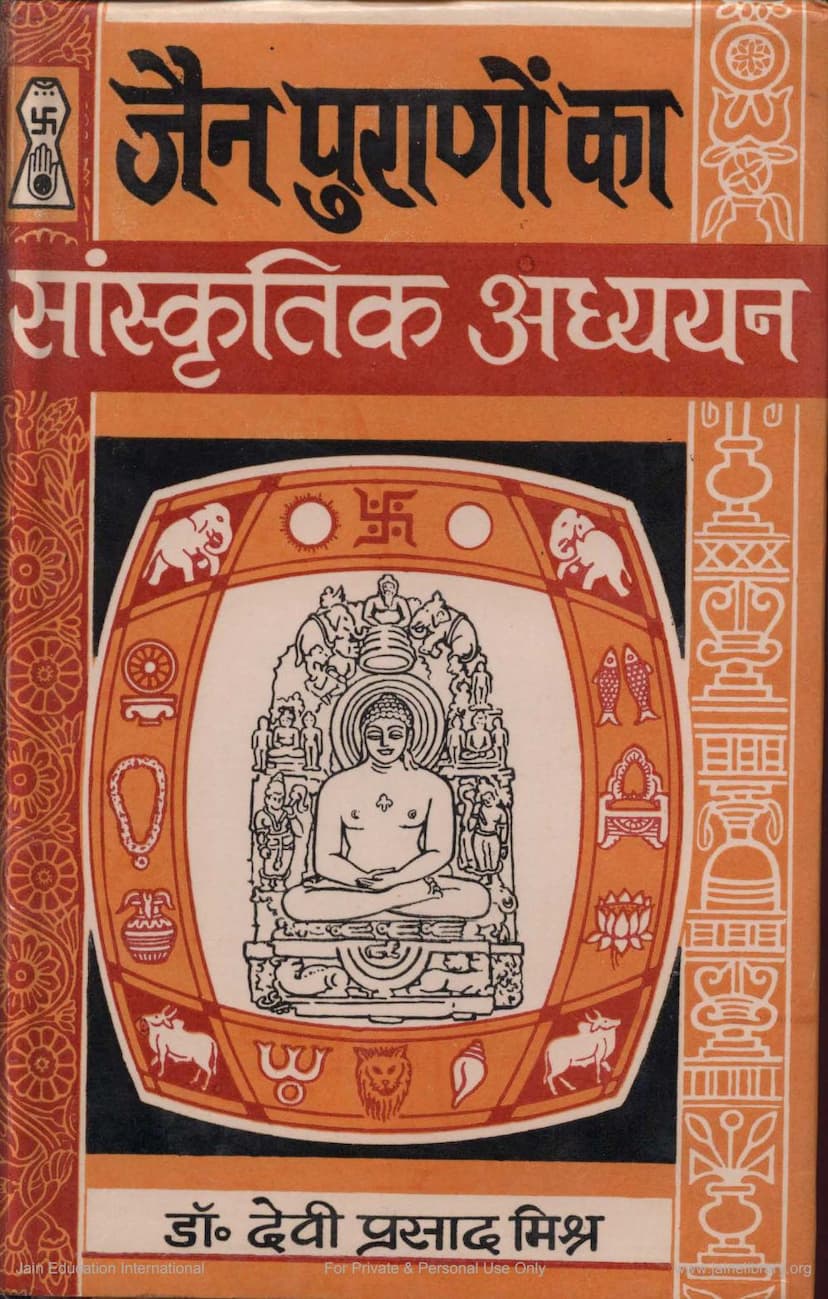Jain Puranoka Sanskrutik Adhyayana
Added to library: September 2, 2025

Summary
This book, "Jain Puranon ka Sanskritik Adhyayana" (A Cultural Study of Jain Puranas) by Dr. Devi Prasad Mishra, published by Hindustani Academy, Allahabad, is a significant and impactful research work. It is lauded for its meticulous research, authentic interpretation of facts, and engaging literary presentation. The author's analytical approach showcases his capability to address many pressing issues in Indian cultural history. The work highlights the author's original research perspective, critical analysis, factual investigation, and comparative study skills. It is considered a guiding light for scholars, enthusiasts, and researchers in Jainology.
The book is praised for its systematic study of cultural material found in Jain Puranas, making it a foundational text for the study of Indian culture. Dr. Mishra has evaluated the significant content of the Puranas in light of contemporary literary, historical, and archaeological evidence, offering a critical discussion within the context of India's diverse cultural traditions. His extensive study, liberal outlook, and unbiased analysis are evident throughout the book, which is considered the first comprehensive cultural study of Jain Puranas and a valuable guide for those studying Indian culture.
Key Themes and Content (Based on the provided Table of Contents):
The book is structured into nine chapters, followed by appendices, covering a wide range of cultural aspects gleaned from Jain Puranas. The author focuses on representative Jain Puranas like Padm Purana, Harivansha Purana, and Maha Purana (Adi Purana and Uttara Purana), composed between the 7th and 10th centuries CE.
The study is organized as follows:
-
Chapter 1: Saakshya-Anusheelan (Evidence Study)
- Interpretation of the word 'Purana' from traditional and Jain perspectives.
- Analysis of the terms 'Itivrtta' (historical account) and 'Itihaas' (history).
- Origin and development of Jain Puranas, covering those based on the Ramayana, Mahabharata, and the Trisatishalaka Purushas (the 63 illustrious persons).
- Dating of Jain Puranas.
- Characteristics of Jain Puranas.
- Background and plan of the present research.
-
Chapter 2: Samajik Vyavastha (Social System)
- Initial structure and the Kulakara tradition (lineage founders).
- Varna-Vyavastha (caste system) and Jain beliefs.
- Ashrama-Vyavastha (stages of life).
- Samskaras (rites of passage) – detailing numerous rituals from conception to salvation.
- Marriage customs and regulations.
- Purusharthas (goals of human life: Dharma, Artha, Kama, Moksha).
- Status of women in society (daughter, wife, mother, widow, warrior, servant, courtesan), including practices like polygamy, purdah, divorce, and Sati.
- Dietary habits (food and drink), including rules, types, cooking methods, and prohibited items.
- Clothing and attire, jewelry, cosmetics, and personal adornment.
- Entertainment and recreational activities (sports, games, music, dance, theater).
- Religious and social festivals.
-
Chapter 3: Rajanaya evam Rajnitik Vyavastha (Diplomacy and Political System)
- Nature and principles of diplomacy.
- The King and the system of governance.
- Military organization.
-
Chapter 4: Shiksha aur Sahitya (Education and Literature)
- Education system, including its importance, rituals, places of learning, teacher-student relationships, and curriculum.
- Literature, covering language and script, Vedic texts, Vedangas, Puranas, various branches of knowledge (grammar, prosody, rhetoric, riddles, mathematics, economics, erotics, music, architecture, drama, medicine, astrology, astronomy, ethics, measurement, engineering, weaponry, tantra, social customs, philosophy).
-
Chapter 5: Kala evam Sthapatya (Art and Architecture)
- Urban settlements (villages, towns, ports, etc.).
- Architecture and construction (city planning, fortifications, buildings, temples).
- Sculpture (Tirthankaras, guardian deities, Yakshas, etc.).
-
Chapter 6: Lalit Kala (Fine Arts)
- Music (principles, types, instruments like lute, drums, flutes, cymbals).
- Dance (characteristics, poses, types).
- Painting (introduction, origin, development, tools, classification, characteristics).
- Miscellaneous fine arts (art of paper cutting, bookbinding, textile art, massage art, garland making, perfumery, painting/coloring).
-
Chapter 7: Arthik Vyavastha (Economic System)
- Economic resources.
- Means of livelihood (military, administrative, agriculture, crafts, trade).
- Trade and commerce (importance, national and international, import-export, currency, measurement systems).
-
Chapter 8: Dharmik Vyavastha (Religious System)
- Philosophical Aspects: Cosmology (lower, middle, upper worlds), Six Dravyas (Jiva, Pudgala, Dharma, Adharma, Akasha, Kala), Seven Tattvas and Nine Padarthas, concept of God from a Jain perspective, Karma theory, Anekantavada and Syadvada, Nayavada.
- Religious Aspects: Conduct of monks (Achara), Yoga, Meditation, Conduct of lay followers (Shravakachara), Deities (types and worship), Yajna (and its opposition), Vedas (and their opposition), Charity (importance, types, and results), Vratas (vows) and Upavasa (fasting).
-
Chapter 9: Bhaugolik Dasha (Geographical Conditions)
- Countries/Nations (Samyukta and Asamyukta regions).
- Cities (Samyukta and Asamyukta cities).
- Mountains (Samyukta and Asamyukta mountains).
- Rivers (Samyukta and Asamyukta rivers).
The book also includes references and indexes, along with an appendix of illustrative plates, likely depicting art and architectural examples relevant to the study. The preface and introductory remarks from esteemed scholars like Dr. Nathmal Tatia and Dr. Gokul Chandra further emphasize the book's academic rigor and importance. The author, Dr. Devi Prasad Mishra, has undertaken a decade-long effort to compile this work, overcoming significant personal and professional challenges, including the theft of an earlier manuscript. The book is dedicated to his late father.
In essence, this book is a monumental achievement, offering an unparalleled insight into the rich cultural tapestry woven through the Jain Puranas, making it an indispensable resource for anyone interested in Jainism, Indian culture, and history.